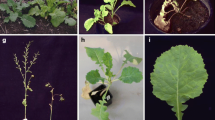Abstract
The corky ringspot disease of potato (Solanum tuberosum) caused by the tobacco rattle virus (TRV) is a serious problem in certain Idaho localities. To investigate natural TRV sources, weeds and plants from rotation crops were randomly collected from six fields with a history of corky ringspot symptoms. Transmission trials, Ouchterlony agar double-diffusion tests, and electron-microscopy showed evidence of TRV in three Idaho counties (Fremont, Ada, and Canyon). Inoculations were made from 27 species and TRV was recovered from the roots of three:Solanum nigrum, Brassica campestris, andErodium cicutarium. Solanum nigrum was the most consistent source of TRV and it generally incited the severest symptoms onNicotiana tabacum (Samsun NN). The results show thatS. nigrum, besides being an important wild host of TRV, may be a useful naturallyoccurring bait plant for detection of TRV in field soils.
Resumen
La enfermedad del “corcho anular” de la papa (Solanum tuberosum) causada por Tobacco Rattle Virus (TRV)*, es un problema serio en ciertos lugares de Idaho.
Para investigar fuentes naturales del TRV se colectaron en forma randomizada, malezas y plantas de cosechas en rotación de 6 campos con historial de síntomas de “corky ringspot”. Ensayos de transmisión, pruebas de “Ouchterlony” agar-doble difusión y por medio del microscopio electrónico se demostró la presencia del TRV en tres localidades (condados) de Idaho: (Fremont, Ada y Canyon). Se hicieron inoculaciones de 27 especies y el TRV fué recuperado de raíces de 3 de ellas:Solanum nigrum, Brassica campestris, y Erodium cicutarium. Solanum nigrum fué la fuente más consistente de TRV y generalmente provoca los síntomas más severos enNicotiana tabacum (Samsun NN). Los resultados muestran queS. nigrum además de ser una maleza hospedera importante del TRV podría utilizarse como una planta “diagnóstico” de ocurrencia natural para la detección del TRV en los suelos de campo.
Similar content being viewed by others
Literature Cited
Allen, T. C. 1963. A strain of tobacco rattle virus from Oregon grown potatoes. Plant Dis. Rep. 10:920–923.
Brandes, J. 1957. Eine elektronenmikroskopishe Schnellmethode zum Nachweis faden-und stäbchenförmiger Viren, insbesondere in Kartoffeldunkelkeimen. Nachrbl. Dtsch. Pfl. Sch. Dienst, Braunschweig. 9:151–152.
Brandes, J. 1964. Identifizierung von gestreckten pflanzenpathogenen Viren auf morphologischer Grundlage. Mitteilungen aus der biologischen Bundesanstalt für land-und Forstwirtschaft Berlin-Dahlem. Vol. 110, 130 pp.
Cadman, C. H. and B. D. Harrison. 1959. Studies on the properties of soil-borne viruses of the tobacco-rattle type occurring in Scotland. Ann. Appl. Biol. 47:542–556.
Cook, H. T. 1949. Corky ringspot found in potatoes from Indiana. Plant Dis. Rep. 33:95.
Cooper, J. I., and B. D. Harrison. 1973. The role of weed hosts and the distribution and activity of vector nematodes in the ecology of tobacco rattle virus. Ann. Appl. Biol. 73:53–66.
Eddins, A. H., E. Q. Proctor, and E. West. 1946. Corky ringspot of potatoes in Florida. Am. Bot. J. 23:330–333.
Eibner, R. 1959. Untersuchungen über das Vorkommen von Tabakmauchebzw. Ratelvirus in Westdeutschland. Nachrbl. Dtsch. Pfl. Sch. Dienst, Stuttgart. 13(7); 104–105.
Gold, A. H., Ray Grogan, and Roy Bardin. 1963. An apparent strain of tobacco rattle virus associated with a yellow spotting of lettuce. Phytopath. 53:1139 (Abstr.).
Lister, R. M., and A. F. Murant. 1967. Seed transmission of nematode-borne viruses. Ann. Appl. Biol. 59:49–62.
Oswald, J. W., and Tully Bowman. 1958. Studies on a soil-borne potato virus disease in California. Phytopath. 48:396 (Abstr.).
Ouchterlony, O. 1958. Diffusion-in-gel methods for Immunological Analysis.In Progress in Allergy. S. Karger, Basel, New York 5:1–78.
Ramsey, G. B., and M. A. Smith. 1947. Corky ringspot of potatoes from Washington. Plant dis. Rep. 31:8–9.
Schmelzer, K. 1957. Untersuchungen über den Wirtspflanzenkreis des Tabakmauchevirus. Phytopath. Z. 30:281–314.
Uschdraweit, H. A., and H. Valentin. 1956. Das Tabakmauchevirus an Zierpflanzen. Nachrbl. Dtsch. Pfl. Sch. Dienst, Stuttgart. 8;132–133.
Walkinshaw, C. H., and R. H. Larson. 1959. Corky ringspot of potato, a soil-borne virus disease. Research bulletin 217, University of Wisconsin, Madison, 31 pp.
Wolcott, A. R., and N. K. Ellis. 1956. Associated forms of internal browning of potato tubers in northern Indiana. Am. Bot. J. 33:343–352.
Author information
Authors and Affiliations
Additional information
Virus del cascabel del tabaco.
Approved by Director of Agricultural Experiment Station as Research Paper No. 74724.
Rights and permissions
About this article
Cite this article
Davis, J.R., Allen, T.C. Weed hosts of the tobacco rattle virus in Idaho. American Potato Journal 52, 1–8 (1975). https://doi.org/10.1007/BF02852099
Received:
Issue Date:
DOI: https://doi.org/10.1007/BF02852099




